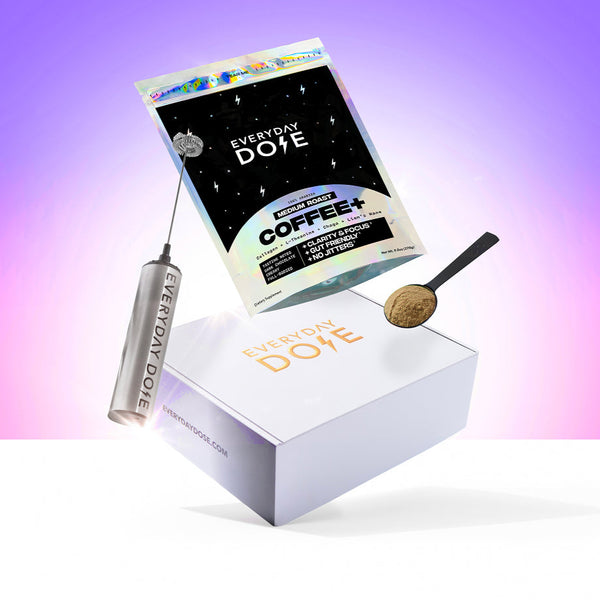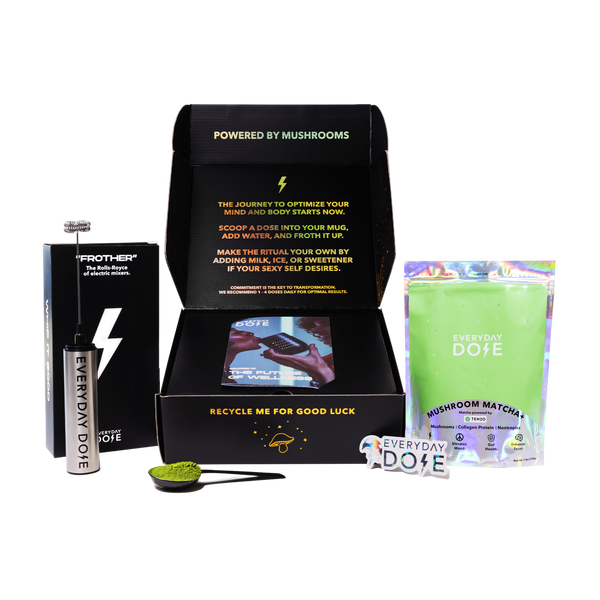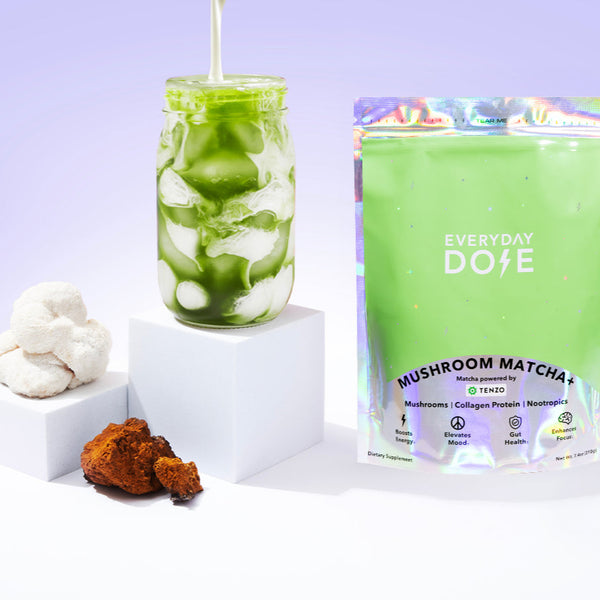How To Get Healthy Skin: 10 Detailed Steps

Getting healthy skin can start to feel like maybe it IS rocket science, especially when you fall into the rabbit hole of skincare social media. There’s an overwhelming number of creams, serums, and jade rollers screaming for your attention, each with a glowing endorsement from your favorite influencers.
But we’re here to tell you that healthy skin isn’t about doing everything — it’s about doing the right things consistently. In this guide, we’ll talk about some basic skincare steps you can take for a natural glow, as well as how you can support healthy skin from the inside out.
Step One: Cleanse
Cleansing might be mainly for removing makeup or post-hot yoga sweat, but it also helps prepare your skin to actually benefit from the products you put on afterward. However, you don’t want to overdo it. Scrubbing too hard or using harsh cleansers can strip away your skin’s natural oils, disrupting its protective barrier. Ultimately, this can lead to dryness, redness, or irritation.
Stick to lukewarm water (not hot), use your fingertips (not a loofah or washcloth), and look for cleansers labeled as fragrance-free and pH-balanced. Afterward, pat (don’t rub!) your face dry with a soft towel.
Step Two: Exfoliate
The right exfoliation routine removes dead skin cells, unclogs pores, and helps your serums get to where they need to go. But the wrong approach can contribute to redness and flaking and may even damage your skin over time. You shouldn’t exfoliate every night, either — gentle exfoliation one to three times per week is enough, depending on your skin type.
And, if you’re using gritty scrubs made, it’s time to upgrade. Chemical exfoliants like alpha hydroxy acids (AHAs) and beta hydroxy acids (BHAs) help dissolve the bonds between dead skin cells, removing the gunk without taking microscopic layers of skin with them.
Lastly, make sure you tailor your exfoliant of choice to your skin type. AHAs (like glycolic or lactic acid) are great for dry or sun-damaged skin, while BHAs (like salicylic acid) work well for oily or acne-prone skin.
Step Three: Moisturize (Show Your Barrier Some Love)
You wouldn’t water your plants once and expect them to survive, right? The same goes for your skin.
Depending on how you do it, moisturizing can help lock in hydration, repair your skin barrier, and keep environmental stressors out. The skin barrier is your face’s frontline defense, and when it’s compromised, everything from bacteria to allergens can sneak in and fade your healthy glow.
Look for ingredient lists that include the following:
- Ceramides
- Hyaluronic Acid
- Shea Butter
- Jojoba Oil
- Rosehip Seed Oil
- Glycerin
- Aloe Vera
Step Four: Apply SPF
If you only do one thing for your skin, wear SPF. UV damage is the number one cause of premature aging, hyperpigmentation, and long-term skin concerns. Dermatologists are very clear: broad-spectrum sunscreen with SPF 30 or higher, every single day, no matter the weather. Yes, even if you're working from a dimly lit office. Yes, even in winter.
And the truth is, most of us aren’t using nearly enough, seeing as you need about a nickel-sized amount for your face alone. Mineral sunscreens with zinc oxide or titanium dioxide are great for sensitive skin, and tinted versions can even double as makeup.
Step Five: Get Plenty of Antioxidants
You can apply all the products in the world, but if your skin isn’t getting the nutrients it needs from the inside, you’ll still be prone to breakouts or dryness. Diets rich in antioxidants have been linked to healthier, more resilient skin.
However, ingesting antioxidants can be just as (or even more) effective than applying them topically. That’s where functional foods like chaga mushroom come in.
Chaga is loaded with polyphenols and melanin, compounds that can protect skin from oxidative stress and help maintain elasticity. Studies show that chaga has some of the highest ORAC (antioxidant capacity) scores among medicinal mushrooms
, making it a no-brainer when it comes to your skin and your immune system.
Step Six: Nourish From Within
You can’t out-serum a bad diet. Your skin is your body’s largest organ, and it reflects what’s going on inside, especially when it comes to your gut. Healthy fats like avocados, olive oil, nuts, and fatty fish provide essential building blocks for supple, well-hydrated skin.
Meanwhile, ultra-processed foods high in sugar and refined carbs can spike insulin, triggering inflammation and breakouts. There’s also the gut-skin axis — basically, your gut bacteria can influence skin irritation, hydration, and even breakouts.
Luckily, ingredients like lion’s mane mushroom are full of prebiotic fiber that can support your good gut bacteria. That’s why we include it in our Mushroom Coffee+, along with chaga mushroom to get your antioxidant numbers up.
Step Seven: Take Collagen
Collagen is the protein that keeps your skin firm, plump, and elastic. As we age, natural collagen production dips, which is why fine lines and sagging start creeping in.
Supplementing with hydrolyzed collagen peptides has been shown in multiple clinical studies to support skin elasticity, hydration, and dermal density. However, collagen can also help strengthen your gut lining, which can support the gut-skin axis.
You can easily stir some collagen into your coffee, but why do that when it’s already an ingredient in our Mushroom Coffee+? That’s right — each serving contains four grams of grass-fed collagen protein to support your skin from the inside out.
Step Eight: Manage Stress Levels
We hate to say it, but stress is not cute. Chronic stress floods your body with cortisol, which disrupts everything from your sleep cycle to your skin barrier. High cortisol levels increase oil production (hello, breakouts), slow wound healing, and even degrade collagen over time. Research also shows that stress increases inflammatory skin conditions like acne, eczema, and psoriasis.
Whether it's meditation, breathwork, therapy, movement, or just laughing with friends, find what helps your nervous system not freak out. And of course, our mushroom blends also contain stress-relieving adaptogens like L-theanine and lion’s mane.
Step Nine: Hydrate
You’ve heard it a thousand times: Drink more water. This is because hydration literally affects every layer of your epidermis. When you're dehydrated, your skin looks dull, flaky, and tight. On the flip side, proper hydration improves skin elasticity, smoothness, and that healthy glow. Water helps flush toxins, transport nutrients, and maintain the skin’s natural barrier.
However, hydration isn’t just about chugging water all day. Make sure you add electrolytes, eat water-rich fruits and veggies, and avoid diuretics like excess caffeine and alcohol.
Step Ten: Monitor for Changes
Paying attention to your skin helps you catch problems early, whether it’s a weird new mole, persistent breakouts, or sudden sensitivity. Experts recommend monthly self-checks for any changes in spots, moles, or patches. And if something’s off, don’t wait — book that dermatologist appointment as soon as you can.
Your skin also shifts with the seasons, hormones, stress, and even diet. So don’t be afraid to tweak your routine based on what your face is actually doing, not what TikTok says it should be doing.
The Bottom Line
Getting healthy skin doesn’t require 30-step routines or magic serums from a skincare shaman. It’s about smart habits, a nourished gut, and choosing ingredients (topical and edible) that support your body’s natural glow-up process.
From SPF to chaga to collagen, the best results come from the inside out. So drink your water, sip your Mushroom Coffee+, and practice a little namaste. And, if you want even more health tips, check out the Everyday Dose blog today!
Sources:
Monthly Mole Check Chart | UMass Memorial Health
Dietary water affects human skin hydration and biomechanics | PMC
How Stress Affects Your Skin and What You Can Do About It | Dermatology Group of the Carolinas
How to Exfoliate Your Skin and When | Water’s Edge Dermatology
Start your day
The Right Way









